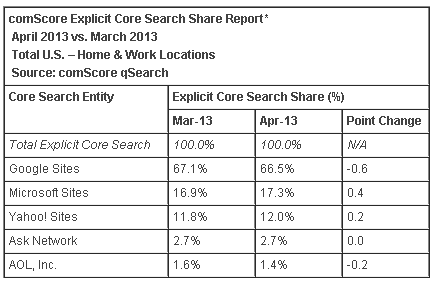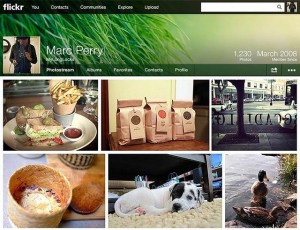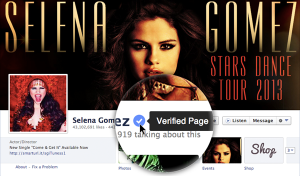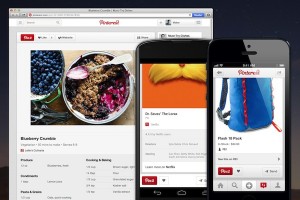Internet Marketing News May Recap
June 3, 2013May was an exciting month for many major industry players. Some celebrated birthdays; while others rolled out new designs and innovative technology.
Before we dive right in, let’s review April’s Share of Search report by ComScore to finish off last month’s April Internet Marketing News Recap.
Bing hit another all-time high passing 17%, partly at the expense of Google who dropped six-tenths of a percent. Yahoo! gained slightly 0.2% up to 12.0%, reversing the earlier downward trend.
Now let’s see what happened in May!
- We begin our May Marketing News recap with Penguin’s anticipated fourth update, Penguin 2.0 generation spam-fighting technology, which launched on May 22nd. Matt Cutts, head of Google’s Web spam team, explained that this will affect roughly 2.3% of English queries. The week prior, Google attacked an unnamed link network affecting several thousand link sellers.
- AdWords rolled out Ad Group Mobile Bid Adjustments which will allow advertisers to make multiple bid adjustments across multiple campaigns without having to click into each target individually.
May was also the month for Google’s annual I/O developer conference in San Francisco, which featured a redesigned Google+ (More details below), Hangout App, Google Maps updates, new gaming API, streaming music via Google Play, and many more exciting announcements. - Diving deeper into Google Maps, Google says it rebuilt maps from the ground up integrating Google earth and street view right in. You can create personalized maps for each city based on searches, saves, and reviews. Basically Google maps can now make recommendations for you based on your interactions. For more details, check out their YouTube video. With this change, Google is also testing new ads via AdWord location extensions. Google Maps also expanded its European biking directions, originally a beta, by adding hundreds of kilometers of bike paths.
- Another thing that came out of Google I/O is conversational search. Users can go to google.com via their Chrome browser and ask questions and Google will respond just like Siri, Google Now, and soon to be Google Glasses. Conversational search takes it a bit further where the user can ask follow up questions using pronouns and Google will remember and understand the conversation.
- Google also expanded its Knowledge Graph to include nutritional information for more than 1,000 foods. Users see the information when searching specifically for the food or ask related questions over voice search such as “How much protein is in a banana”.
Bing
- Bing announced a new visual way for its users to consume news. Bing’s results page will feature a revolving carousel of images on top of the SERP for notable people, similar to Google’s knowledge graph Carousel from last year. If Bing cannot find fresh content within the last two weeks, it will serve up relevant results even over the last several years.
- Bing also made some updates to its social search. Within its results page, Bing now features Klout integration with Klout Experts. This allows searches to find valuable answers to their questions by verifying the authorship through Klout.
- On the sidebar, Bing now allows direct Facebook Interaction. Searchers can now comment on Facebook directly through the Bing social sidebar encouraging social conversation without leaving the search page.
- Slightly off topic, but Microsoft announced its latest device Xbox One. This latest console includes innovative gaming technology paired with the latest Microsoft Kinect giving the Xbox real vision, motion, and voice. This allows users to play games, play live TV, connect with friends over Skype as well as connect to numerous apps. The exciting part for search is that Kinect allows the user to control the Xbox by speaking to it, all powered by Bing. Below is a video of the unveiling.
Yahoo!
- Despite CEO Marissa Meyers expressing unhappiness with the Bing Yahoo relationship back in February, Yahoo declared an extension to Microsoft’s revenue per search deal for another 12 months. On that same day, Yahoo announced it will expand its search-ads relationship with Chitika into mobile. This ad network already appears on Yahoo! Answers and Local, and syndicates Yahoo/Bing text ads across its network
- Yahoo made some changes to its front-page new stream. First, Yahoo debuted a new ad format displaying a customizable ad alongside news articles. Yahoo also now includes relevant and personalized tweets in the newsfeed.
- Yahoo continued to make big waves in the news with its purchase of Tumblr for $1.1 billion. Marissa Mayer announced it on her Tumblr page saying, “We promise not to screw it up. Tumblr is incredibly special and has a great thing going. We will operate Tumblr independently.” Yahoo reportedly also put in a bid to buy the “secretly for sale” Hulu.
- Speaking of brands recently bought by Yahoo, Flickr unveiled the new user experience with larger images and much more storage. Below is a look at the new Flickr.
YouTube
- May marks YouTube’s 8th anniversary since the first video was posted on their site. In a blog post, YouTube announced it now sees more than 100 hours of video uploaded every minute as well as more than a billion people come to YouTube every month.
- Rumored since January, YouTube launched paid channels with subscription fees starting as low as $0.99 monthly for pilot channels. Users who subscribe will be able to watch paid channels on a computer, phone, tablet, and TV.
- YouTube also announced two new features to help video publishers. The first is automatic email notifications for when a video is done uploading. The second is that this uploaded video is automatically private, allowing users to input title, description, and fully optimize the video before going live.
- Building from Facebook’s largest announcement in April, Facebook Home, May brought some good and bad news to the social media giant. While Facebook Home hit over 1 million downloads exactly a month after being launched, HTC slashed the price of the Facebook Home down to 99 cents with a two year contract.
- In the beginning of May, Facebook globally rolled out Promoted Page Likes, ads geared at gaining new fans which launched in the US in 2012. Facebook also began improving their newsfeed and right column ads by increasing the image size limit for a select few advertisers.
- To help its users find authentic accounts of celebrities and other high profile people and businesses, Facebook announced Verified Pages which adds a small blue check mark besides their name on timeline, search results, and throughout Facebook. Below is an example.
- Twitter kicked off May by opening its ad self-serve platform to all US users. Twitter also made some updates in its ad center to provide advertisers with more details on the tweets audience like device, location, gender, and interests.
- In addition, Twitter announced Lead Generation Cards in attempt to offer richer forms for advertising. Now users can expand a tweet they are interested in to see a brand’s offer. This offer will have a call to action button that will email you details. This also allows advertisers to collect email addresses for future email marketing campaigns.
- Lastly, after a year chock-full of twitter hackings, Twitter finally introduces two-step authentication via SMS to protect its accounts.
Google+
- May was a month of redesign for Google+ to a much more visual profile. The desktop site got an image heavy redesign including a much larger cover photo which takes up to half of the screen above the fold. Check out the Catalyst Google+ Page for an example. The mobile version received a redesign a week later where posts appear like cards, increasing readability and shareability as well as larger cover photos.
- Google Offers also arrived to Google+ so users can now see limited time promotions directly on their news stream if they follow brands that participate in the program such as Zagat, Hello Kitty, Nook, and art.com.
- The last update from Google+ is Google’s decision to remove Google+ Games, one of the less popular features, from the social network on June 30th.
- LinkedIn celebrated its 10th birthday in May. It has grown to more than 200 million users, 3,700 employees, and 26 offices around the world.
- LinkedIn adds the ability to feature visual content on a user’s profile such as pictures and videos. This content can be added to the summary, work experience, or education section and other users can choose to like, comment, or share it.
- Pinterest redesigned their mobile app to include search suggestions, push notifications, and the ability to mention friends in their posts.
- In addition, Pinterest launched new “Rich Pins” that contain more information from the original site such as product purchase information or ingredients and recipes. Users no longer have to spend additional time tracking down information regarding a Pin and this is one step closer to monetized conversions for Brands.
What’s New at Catalyst?
- Heather Frahm, our President and co-founder, has decided to resign from Catalyst and spend more time with her family. Beth LeTendre, co-founder and CEO, will assume her responsibilities. While her last day is undetermined, our Director of Sales & Marketing Rich Ezzo interviewed Heather on her departure from Catalyst.
- Ben Spiegel, Director of Organic Search spoke on Making it Jive: Using Data to Make (and Improve) SEM Decisions at Interactivity Digital. Check out his presentation below:
- In addition, Ben Spiegel wrote an article on ClickZ How to Create Actionable Insights From YouTube Search Data.
- Lastly, Dan Cristo, Director of SEO Innovation, wrote an article on Search Engine Journal HTML5: An Essential Weapon for SEOs.
- For more frequent updates on Catalyst news, industry events, and featured articles check out our new company news page.
- Sign Up for the Catalyst Must-Have Digital Insights e-Newsletter for the latest thought leadership, industry updates, and Catalyst news.
- Catalyst is Hiring! We have open positions in each of our offices, check out our Career Page for the latest open positions.
Have any questions about any of the above stories or think we missed something? Let us know in the comment section below. Also, be sure to check back in early July for our June monthly recap!









